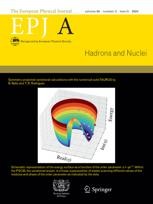Paving the way for effective field theories
A detailed analysis of theories which approximate the underlying properties of physical systems could lead to new advances in studies of low-energy nuclear processes
New York | Heidelberg, 1 February 2021
 Over the past century, a wide variety of models have emerged to explain the complex behaviours which unfold within atomic nuclei at low energies. However, these theories bring up deep philosophical questions regarding their scientific value. Indeed, traditional epistemological tools have been rather elaborated to account for a unified and stabilised theory rather than to apprehend a plurality of models. Ideally, a theory is meant to be reductionist, unifying and fundamentalist. In view of the intrinsic limited precision of their prediction and of the difficulty in assessing a priori their range of applicability, as well as of their specific and disconnected character, traditional nuclear models are necessarily deficient when analysed by means of standard epistemological interpretative frameworks.
Over the past century, a wide variety of models have emerged to explain the complex behaviours which unfold within atomic nuclei at low energies. However, these theories bring up deep philosophical questions regarding their scientific value. Indeed, traditional epistemological tools have been rather elaborated to account for a unified and stabilised theory rather than to apprehend a plurality of models. Ideally, a theory is meant to be reductionist, unifying and fundamentalist. In view of the intrinsic limited precision of their prediction and of the difficulty in assessing a priori their range of applicability, as well as of their specific and disconnected character, traditional nuclear models are necessarily deficient when analysed by means of standard epistemological interpretative frameworks.
The theoretical construct brought by so-called effective field theories allows a better articulation of the tension between the natural reductionist force at play in physical sciences and the need to account for phenomena emerging at various energy/spatial scales in complex systems such as the atomic nucleus. Because of the various scales involved, a tower or tree-like hierarchies of inter-related effective field theories is inherently necessary and thus needs to be formulated and articulated. This is mandatory to develop a coherent, efficient and salient description of the zoology of nuclear phenomena.
This special issue, published in EPJ A, presents a coherent collection of work by theoretical experts from around the world regarding the use of effective field theories. Several unanswered questions are addressed and clarified, leading to detailed assessments of the philosophical foundations of effective field theories. The collected studies show how these ideas become relevant in low-energy nuclear systems, as well as in biological and gravitational systems – which have comparable levels of underlying complexity. The outcomes of this research pave the way for new advances in the wider-field of low-energy nuclear physics.
All articles of the Topical Issue on The tower of effective (field) theories and the emergence of nuclear phenomena, edited by V Bontems, T Duguet, G Hagen, V Somà (2020) are available here and are freely accessible until 28 March 2021. For further information, please read the Editorial.
Reference: Bontems, V., Duguet, T., Hagen, G. et al. Topical issue on the tower of effective (field) theories and the emergence of nuclear phenomena. Eur. Phys. J. A 57, 42 (2021). DOI 10.1140/epja/s10050-021-00356-4
Further Information
For more information visit: www.epj.org
Services for Journalists
The full-text article is available here.
Contact
Sabine Lehr | Springer | Physics Editorial Department
tel +49-6221-487-8336 | sabine.lehr@springer.com
